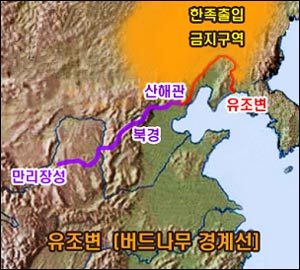[.....]
YiYi JeYi 이이제이以夷制夷 means
to destroy an enemy, using another enemy. This strategy is what the Chinese have
historically preferred to use. Chinese see that a battle can’t be won only with
the valour of an army.
The Chinese had to win their surrounding nomadic tribes with
a trick, when they couldn’t compel the tribes with the force of the army alone.
That’s why, right up to this day, they see that the best tactic is to oppress
an enemy with another enemy, and thus gain surrender without a battle.
[.....]
[.....]
Although DongYiJok (JuShinJok) could shoot archery well and
have a strong military army with an open mind, the Chinese seemed to understand
that this very willingness to be open minded and consider many points of view
also meant that they can be deceived. By taking a divide and conquer approach,
the tribes’ humanity and cohesion could be negatively influenced.
The Chinese realize that DongYiJok (JuShinJok) can be in
cooperation with them when they successfully coax and alienate DongYiJok
(JuShinJok) from other DongYiJok.
JeGal-ryang (諸葛亮) (of 삼국지 三國志 History of three states: 181~234, a prime minister of one
of Three Countries) also told that YiYi JeYi was an essential strategy to win nomadic
tribes like GoGuRyeo, and was used to collapse GoGuRyeo in 697, by an allied
army of the Shilla dynasty in the Korean peninsula and TaeJong in Tang dynasty
in China.
He wrote about 동이 DongYi 東夷 (meaning eastern barbarian - a degraded name of Korean ancestors called by Chinese
ancestor in the past) and said in his book that we can’t attack DongYi
because they are socially well-associated with each other. So we should first
create alienation among their royalty, officials and people, so that they are
not socially well-associated with each other. And although we succeed in this
operation, we will still need to make them feel safe, especially by sending our
diplomats to their country frequently “to promote friendship with each other”.
This ensures that they are unprepared against our sudden attack. After that, we
can conquer them with our strong army through our unexpected invasion or sudden
attack.
[.....]
[.....]
One of DaeJuShinJok 대쥬신족(Dae: big, JuShin: a name
for Mongolian tribes in Northern East Asia, defined by the writer, Jok:
tribes), the Qing dynasty had treated nomadic tribes not with YiYi JeYi
but with a concept of brotherhood which was quite different from how
other dynasties built by Chinese had done.
The Qing dynasty had
made much effort to protect JuShinJok, who were a main ruling group of the Qing
dynasty, from being assimilated in any way with the Chinese ('Han' race). In the
beginning of the Qing dynasty, a main group of power intended to return to
their homeland, Manchuria, anytime if they would lose their power in China .
The most outstanding example was 유조변YuJoByeon
(a willow tree fence or hedge – purple line on the below map ) that helps
us understand the Qing dynasty’s approach to maintaining separate
identities. This willow fence ranged for about 975 km, beginning at 산해관 Shanhaiguan (山海關) passing through HeungGyeong (Ssing Jing in Chinese) in
the North East and reached the mouth of the 압록강ApRokGang
river - in North Korea today. Afterwards, 345 km of willow fence was built again.


YuJoByeon established in Qing dynasty. (footnote: Korean words in yellow on the above map says "Forbidden area to Chinese." © pressian
The Qing dynasty used YuJoByeon (willow tree fencing) to protect JuShinJok from becoming Chinese and to forbid Chinese from going to the farmland of YoDong 요동 (in Far East Manchuria ) by designating nomadic areas for Mongolians. Meanwhile the willow tree fence was also in case of the emergency of the Qing dynasty needing to evacuate or withdraw fromChina . Therefore, they prohibited
Chinese from living in the Northern East area of Manchuria .
The Qing dynasty used YuJoByeon (willow tree fencing) to protect JuShinJok from becoming Chinese and to forbid Chinese from going to the farmland of YoDong 요동 (in Far East Manchuria ) by designating nomadic areas for Mongolians. Meanwhile the willow tree fence was also in case of the emergency of the Qing dynasty needing to evacuate or withdraw from
[....]
This kind of national policy of the Qing dynasty shows it
was quite different from what the previous Chinese countries had enforced
through 이이제이 YiYi JeYi. While Chinese
dynasties had used any methods and ways to disrupt nomadic tribes with YiYi JeYi policy, the Qing dynasty
proceeded on enforcing their national homogeneity by a policy of intermarriage
with Mongolia .
The Qing dynasty called Mongolia “the
country of brother” (or brother's country) and showed off mutual union through
hunting competitions. This shows that the Qing dynasty were not rooted on
Chinese but 대쥬신DaeJuShin, who were nomadic tribes in Northern
East, west of Altai.
[.....]
-----------------
[.....]
-----------------
Original Source: 김운회의 '대쥬신을 찾아서' by 김운회 (Kim Woon Hoe, a historian and a professor at Dong-yang University)
http://www.pressian.com/news/article.html?no=47171
http://www.pressian.com/news/article.html?no=47171
어느 만주족의 글
ReplyDeletehttp://blog.daum.net/21010/1218
Manchurians who had tried so hard to protect themselves from being assimilated in any way with Han race were eventually wiped out by Han race, and the survivors (estimated 10 million) had to hide their ethnic identities. They now live in fear in China.
멸만흥한 [滅滿興漢]
http://terms.naver.com/entry.nhn?docId=1093093&cid=40942&categoryId=33398